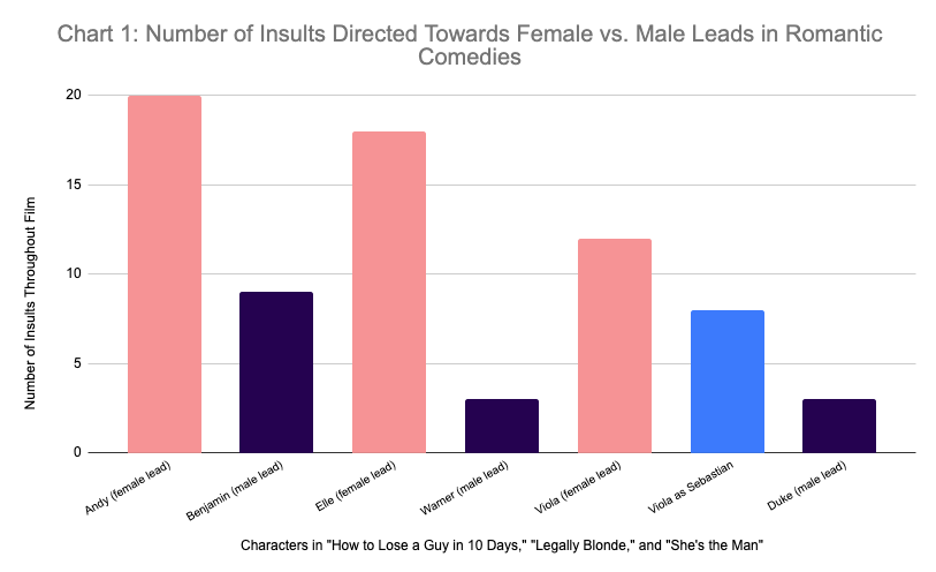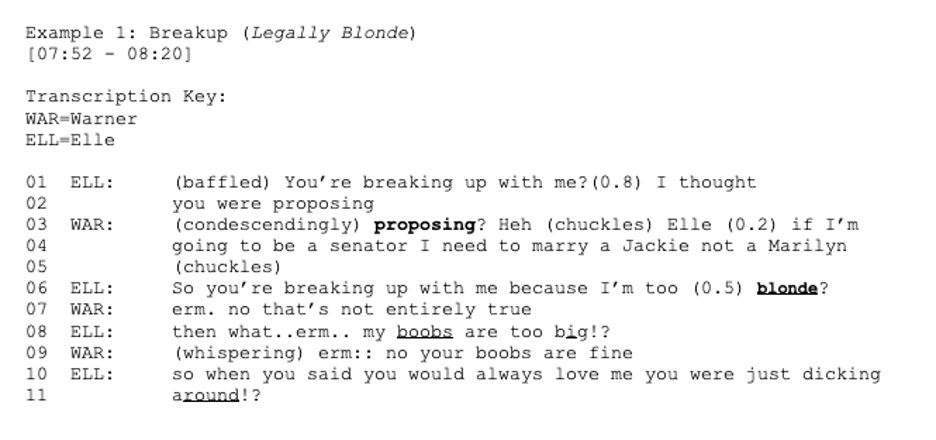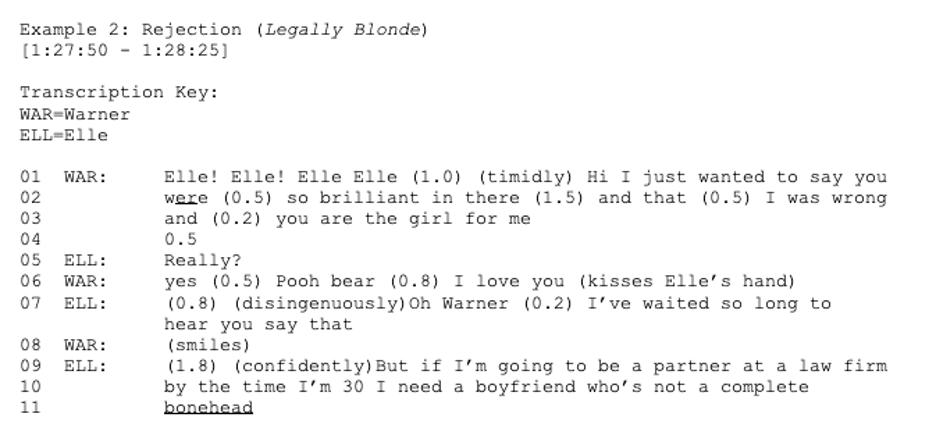Tina Izad
While previous studies have explored the gendered differences in linguistic traits and plot lines between male and female main characters, they have failed to provide significant focus on the differences in insults directed towards male and female main characters and the gender stereotypes which these differences may be perpetuating. Thus, this blog will analyze how differences in intonation, word choice, and the impact of insults on male versus female main characters in romantic comedy movies perpetuate gender stereotypes. These stereotypes include the ideas that men demonstrating emotion is a sign of weakness, females categorically demonstrate inherently inferior capabilities intellectually, physically, and professionally, that a woman’s primary occupation should be to maintain a specific aesthetic appearance, and if she does not, she should anticipate, if not expect, to be insulted, and, finally, the idea that a female needs a heteronormative relationship in order to feel fulfilled and truly succeed. Thus through the stereotypes perpetuated through insults, romantic comedies may contribute to the systemic oppression of women and subsequently uphold the socially antiquated gender binary.
Introduction and Background
In an era in which technology is central to our lives and learning, film has developed the power to color our perceptions and sway our understanding of social norms. Romantic comedies are no stranger to this, as not only their plotlines but also their use of linguistic properties exhibit significant differences between male and female main characters. For example, a study at Heriot Watt University at Edinburgh found that enjoying the romantic comedy, “The Wedding Planner,” a film based on an engaged man falling in love with his wedding planner, was associated with poor communication with romantic partners, thus demonstrating the powerful influence romantic comedies may have over our interactions.
Previous studies have failed to draw attention to the differences in insults directed towards male and female main characters; thus, this blog will analyze how differences in intonation, or shifts in pitch and volume, word choice, or the deliberate presentation of certain language, and the impact of insults on male versus female main characters in romantic comedy movies perpetuate gender stereotypes. These stereotypes include the ideas that men demonstrating emotion is a sign of weakness, females categorically demonstrate inherently inferior capabilities intellectually, physically, and professionally, that a woman’s primary occupation should be to maintain a specific aesthetic appearance, and if she does not, she should anticipate, if not expect, to be insulted, and, finally, the idea that a female needs a heteronormative relationship in order to feel fulfilled and truly succeed. Thus through the stereotypes perpetuated through insults, romantic comedies may contribute to the systemic oppression of women and subsequently uphold the socially antiquated gender binary.
This study focused on the three romantic comedies “She’s the Man,” “How to Lose a Guy in 10 Days,” and “Legally Blonde.” Although the insults in all three films were analyzed in depth, this blog will focus on gendered differences in insults in the film “Legally Blonde.” “Legally Blonde” focuses on the main character Elle Woods, a sorority president, who makes her way into Harvard Law after her Harvard Law boyfriend, Warner, the male main character, breaks up with her to find a more serious relationship which will put him on the right path towards eventually becoming a senator.
Methods
 While watching each film, I took notes on the context of each insult, the speaker and the recipient, word choice, intonation, impact of the insults, and the frequency of insults directed towards the male and female main characters in each film. Close attention was paid towards insults perpetuating gender stereotypes including the need for males and females to adhere to heteronormative societal standards, women’s obligation to maintain a specific aesthetic appearance and that her appearance contributes to her worth as a person, the necessity for women to act lady-like (including the need to not be “too” sexually active) to be accepted, the idea that women are inherently inferior intelligently, physically, and professionally, and that men must refrain from showing emotion in order to appear manly.
While watching each film, I took notes on the context of each insult, the speaker and the recipient, word choice, intonation, impact of the insults, and the frequency of insults directed towards the male and female main characters in each film. Close attention was paid towards insults perpetuating gender stereotypes including the need for males and females to adhere to heteronormative societal standards, women’s obligation to maintain a specific aesthetic appearance and that her appearance contributes to her worth as a person, the necessity for women to act lady-like (including the need to not be “too” sexually active) to be accepted, the idea that women are inherently inferior intelligently, physically, and professionally, and that men must refrain from showing emotion in order to appear manly.
Results
Among the three studied romantic comedies, the frequency of insults directed towards the female main characters was approximately triple that of the frequency of insults directed towards the male main characters, with the exception of the number of insults directed towards Viola in “She’s the Man,” while she is disguised as Sebastian (as shown in Chart 1). Across the three films, there were a total of 50 insults directed towards female main characters and a total of 15 directed towards male main characters and an additional 8 which were directed towards Viola while she was “Sebastian.” Furthermore, of the 15 male-directed insults, five were in regard to the male lead’s intelligence and professional abilities, 2 were directed at his sexuality or sexual performance and one was about him being too lady-like or not manly enough. This does not include the six insults directed towards Viola dressed as Sebastian which were about “him” not being masculine enough. Among the 50 insults directed towards the female main characters in these movies, 21 were in regard to her intelligence and professional abilities, 10 were about her sexuality and/or appearance and five were about her being too manly, or not lady-like enough.

Gentler and more polite word choice with less negative connotations both emotionally and historically and softer intonation were used more in male-directed insults than in female-directed insults. Additionally, across all three films, the female lead’s goals were talked down upon, mainly by men and she was spoken to as if her career aspirations were outlandish, while men in the same positions were not questioned. Lastly, the male-leads responded more strongly to the insults directed towards them, while the female leads brushed off insults more often.
Discussion
The delivery and impact of insults vary based on if they are directed towards male or female leads. Through all three films, the male-lead reacted much more shocked when insulted, emphasizing the infrequency at which this occurs. In contrast, women seem to nearly anticipate insults as they tend to react in a more muted fashion and will even insult themselves while attempting to understand others’ decisions about them. In “Legally Blonde,” while at dinner, Elle is broken up with by her boyfriend, Warner. The following transcription depicts Elle’s response to the breakup and Warner’s explanation to his decision, much of which exemplifies Elle’s socially induced perception that her appearance constitutes a significant portion of her worth as a person and Warner’s misogynistic leaning and disrespect towards Elle.

As Elle is baffled, stating that she anticipated a proposal, Warner responds, while chuckling with lines 3-4. Elle immediately responds to this misogynistic insult by questioning if his rejection of her has to do with her boob size or hair color, further emphasizing her perception that a significant portion of her worth as a woman has to do with her external appearance.
Furthermore, Elle does not react to Warner’s insult in itself, ignoring the sexist leaning of his comparison of her to Marilyn Monroe, who was thought to have had an affair with John F. Kennedy, and contrasting of her character with Jackie Kennedy, who was viewed as more sophisticated and classier. Elle’s lack of response to the insult in itself emphasizes her possible expectation for such misogynistic comments. This loaded insult from Warner can be contrasted with a later insult from Elle directed towards Warner, as shown in example 2.

Elle adopts the same format as Warner’s insult, and responds with lines 9-11. While it is noteworthy that she adopted the same structure, “bonehead” is a far less condemning and charged insult than Warner’s comparison. Further, Warner’s speechless reaction indicates that he likely is not insulted often, even in this somewhat elementary way.
Additionally, while Elle’s insult towards Warner in lines 9-11 of example two is said with confidence, implying respect for herself, Warner insults Elle in line three of example one with a condescending tone, outwardly implying a lack of respect for her and belittling her intelligence. This contrast in tone demonstrates the way in which insults towards male main characters may be softened, whether through intonation or other methods, to reduce the insult’s impact, while the same considerations are often not taken with women.
Conclusion
The results of this study corresponded to previous research done on gender differences in romantic comedies, however it is worth noting that limitations were present in this study, as all three films held a primarily straight, white, cis-gendered cast. This lack of diversity limits the applicability of the study to society as a whole and also emphasizes the need for greater diversity in film. This study in particular shone a light on the differences in insults directed towards male and female main characters and the ways in which not only the words verbalized, but also the tone of voice used during these insults along with the impact of these insults contribute to the perpetuation of gender stereotypes and thus continuously normalize a gender binary and the acceptance of outdated gender roles.

References
Angyal, C. S. (n.d.). GENDER, SEX, AND POWER IN THE POSTFEMINIST ROMANTIC COMEDY. Retrieved February 6, 2021, from Edu.au website: http://unsworks.unsw.edu.au/fapi/datastream/unsworks:12432/SOURCE02?view=true
How to Lose a Guy in 10 Days. (2003). Available from https://play.google.com/store/movies/details?id=6SHj4gXvPk8&gl=US&utm_source=na_Med&utm_medium=hasem&utm_campaign=MoviesPLA&pcampaignid=MKT-DR-na-us-all-Med-pla-mo-Evergreen-Dec1115-1-movieslibrary&gclid=CjwKCAiA9vOABhBfEiwATCi7GAK5dyy7YlgLnuPH5FR_Kv-W_e1CtcYpk1hJgOlwNaA_05DM9_qMIBoCtQ0QAvD_BwE&gclsrc=aw.ds
José Mateo, F. Y. (n.d.). Towards an intercultural pragmatic taxonomy of insults. Retrieved February 12, 2021, from Personal.ua.es website: https://personal.ua.es/francisco.yus/site/insults.pdf
Lauzen, M. (2016, June 8). Articles about our Research. Retrieved February 25, 2021, from Sdsu.edu website: https://womenintvfilm.sdsu.edu/contributions/about-our-research/
Legally Blonde. (2001). Available from https://www.amazon.com/gp/video/detail/amzn1.dv.gti.f8a9f71d-741f-7cff-a561-efc0b720b6d9?autoplay=1&ref_=atv_cf_strg_wb
Legally Blonde wallpapers – wallpaper cave. Retrieved from https://wallpapercave.com/legally-blonde-wallpapers
Raymond, C. W. (2013). Gender and sexuality in animated television sitcom interaction. Discourse & Communication, 7(2), 199–220.
Scharaga, J. A. (n.d.). Female moments / male structures: The representation of women in romantic comedies. Retrieved February 6, 2021, from Ursinus.edu website: https://digitalcommons.ursinus.edu/cgi/viewcontent.cgi?article=1008&context=media_com_hon
She’s the Man. (2006). Available from https://www.amazon.com/Shes-Man-Amanda-Bynes/dp/B015O3MPZA
The representation of love in Romantic Comedies. (n.d.). Retrieved February 25, 2021, from Centreforjournalism.co.uk website: https://centreforjournalism.co.uk/content/representation-love-romantic-comedies
Vignozzi, L. B. A. (n.d.). Gender Stereotypes in Film Language: A Corpus-Assisted Analysis. Retrieved February 6, 2021, from Openedition.org website: https://books.openedition.org/aaccademia/2367?lang=en
Wright, B. (n.d.). Gender and language: Challenging the stereotypes. Retrieved February 6, 2021, from Birmingham.ac.uk website: https://www.birmingham.ac.uk/Documents/college-artslaw/cels/essays/sociolinguistics/Wright5.pdf